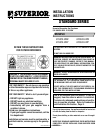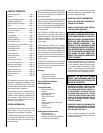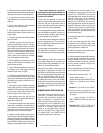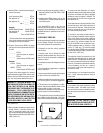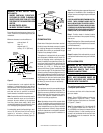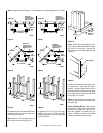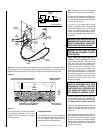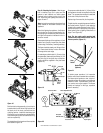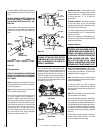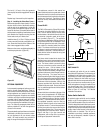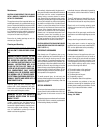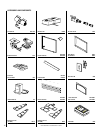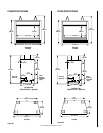
NOTE: DIAGRAMS & ILLUSTRATION NOT TO SCALE.
3
The National Fuel Gas Code defines a con-
fined space as a space whose volume is less
than 50 ft
3
per 1,000 BTU/Hr (4.8 m
3
per kw)
of the aggregate input rating of all appliances
installed in that space and an unconfined
space as a space whose volume is not less
than 50 ft
3
per 1,000 BTU/Hr (4.8 m
3
per kw)
of the aggregate input rating of all appliances
installed in that space. Rooms communicat-
ing directly with the space in which the appli-
ances are installed, through openings not
furnished with doors, are considered a part of
the unconfined space.
Unusually tight construction is defined as con-
struction where:
a. wall and ceilings exposed to the outside
atmosphere have a continuous water vapor
retarder with a rating of one perm or less with
openings gasketed or sealed, and
b. weather stripping has been added on oper-
able windows and doors, and
c. caulking or sealants are applied to areas such
as joints around window and door frames,
between sole plates and floors, between wall-
ceiling joints, between wall panels, at penetra-
tions for plumbing, electrical, and gas lines,
and at other openings.
Use the following equations to determine if you
have a confined or unconfined space.
1.Determine the volume of space — ft
3
.
Length x Width x Height = _____ ft
3
(Include adjoining rooms with doorless pas-
sageways or ventilation grills between
rooms.)
Example: 24' (L) x 16' (W) x 8' (H) = 3072 ft
3
2.Divide the volume of space by 50 ft
3
to
determine the maximum BTU/hr the space
can support.
______ (volume of space – ft
3
)/ 50 ft
3
x
1000 = (Maximum BTU/hr the space can
support)
Example: 3072 ft
3
/ 50 ft
3
x 1000 = 61.44
or 61,440 BTU/hr the space can support.
• Children and adults should be alerted to the
hazards of high surface temperatures and should
stay away to avoid burns or clothing ignition.
• Young children should be carefully super-
vised when they are in the same room with the
appliance.
• Do not place clothing or other flammable
material on or near the appliance.
• Never operate this appliance without first
ensuring that the glass enclosure panel is se-
curely in place.
• Do not burn solid fuels in this listed unvented
gas room heater.
• Installation and repair should only be com-
pleted by a qualified service person. The appli-
ance should be inspected before use and at
least annually by a professional service person.
More frequent cleaning may be required due to
excessive lint from carpeting, bedding mate-
rial, etc. It is important that control compart-
ments, burners and circulating air passage-
ways of the appliance be kept clean.
• Allow the appliance to cool before servicing.
Always shut off the gas to the appliance while
performing service work.
• Do not install these appliances in a bedroom
or bathroom as all units exceed maximum
allowable BTU/hr input of 10,000.
• The appliance and its individual shut-off valve
must be disconnected from the gas supply
piping system while performing any tests of the
gas supply piping system at pressures in ex-
cess of ¹⁄₂ psig.
• The appliance must be isolated from the gas
supply piping system by closing its individual
manual shut-off valve during any pressure test-
ing of the gas supply piping system at test
pressures equal to or less than ¹⁄₂ psig.
• Keep appliance area clear and free from
combustible materials, gasoline and other flam-
mable vapors and liquids.
• Do not use this appliance if any part has been
under water. Immediately call a qualified ser-
vice technician to inspect the appliance and to
replace any part of the control system and any
gas control which has been under water.
• Operation of these catalytic systems at alti-
tude will result in sporadic nuisance outages of
the pilot system due to lack of sufficient oxygen,
increasing in frequency as the altitude increases
above 4,500 feet. Although this situation is not
dangerous, pilot outages cannot be tolerated.
• These catalytic appliances are rated for
use at altitudes no greater than 5,500 feet. Do
not install and use this appliance in locations
in excess of this altitude.
• Ensure that the appliance is clean when
operating. Excessive dust accumulation on the
burner and logs will increase the amount of
carbon monoxide formation and could lead to
carbon monoxide poisoning and death.
• Provide adequate clearances around air open-
ings and adequate accessibility clearance for
service and proper operation. Never obstruct
the front openings of the appliance.
• These appliances are designed to operate on
natural or propane gas only. The use of other
fuels will degrade the performance of this sys-
tem and may be dangerous.
• Do not tamper with the appliance in any way.
Any modifications will result in a voided war-
ranty and could result in CO poisoning or death.
CODES
These appliances comply with American Na-
tional Safety Standards and are tested and
listed by IAS Services to AGA/ANSI Z21.11.2b-
1995 as an “Unvented Room Heater.”
Adhere to all local codes or in their absence the
latest edition of The National Fuel Gas Code
ANSI Z223.1 or NFPA54 which can be obtained
from The American National Standards Insti-
tute, Inc. (1430 Broadway, New York, NY,
10018) or National Fire Protection Association,
Inc. (Batterymarch Park, Quincy, MA, 02269).
All electrical wiring must be in accordance with
local codes or in the absence of local codes the
latest edition of the National Electrical Code,
ANSI/NFPA 70.
COMBUSTION AND VENTILATION AIR
These heaters shall not be installed in a con-
fined space. The heater may be located in
unusually tight construction provided the
space is unconfined, or if confined, is pro-
vided with two permanent openings commu-
nicating directly with an additional room(s)
of sufficient volume so that the combined
volume of all connected spaces meets the
criteria for an unconfined space, (National
Fuel Gas Code ANSI Z223.1 1992, Section
5.3). Generally 50 ft
3
per 1,000 BTU input of
all operating appliances in the space.



